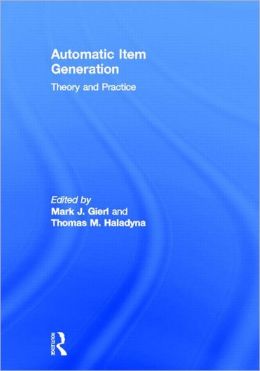 [内容简介]
[内容简介]
Automatic item generation (AIG) represents a relatively new and unique research area where specific cognitive and psychometric theories are applied to test construction practices for the purpose of producing test items using technology. The purpose of this book is to bring researchers and practitioners up-to-date on the growing body of research on AIG by organizing in one volume what is currently known about this research area. Part I begins with an overview of the concepts and topics necessary for understanding AIG by focusing on both its history and current applications. Part II presents two theoretical frameworks and practical applications of these frameworks in the production of item generation. Part III summarizes the psychological and substantive characteristics of generated items . Part IV concludes with a discussion of the statistical models that can be used to estimate the item characteristics of generated items, features one future application of AIG, describes the current technologies used for AIG, and also highlights the unresolved issues that must be addressed as AIG continues to mature as a research area.
Comprehensive – The book provides a comprehensive analysis of both the theoretical concepts that define automatic item generation and the practical considerations required to implement these concepts.
Varied Applications – Readers are provided with novel applications in diverse content areas (e.g., science and reading comprehension) that range across all educational levels – elementary thru university.
[目录]
Part I. Initial Considerations for Automatic Item Generation
1. Automatic Item Generation: An Introduction Mark J. Gierl and Thomas M. Haladyna
2. Automatic Item Generation: A Historical Perspective Thomas M. Haladyna
3. Using Weak and Strong Theory to Create Item Models for Automatic Item Generation: Some Practical Guidelines with Examples Mark J. Gierl and Hollis Lai
4. Item generation: Implications for a validity argument Isaac I. Bejar
Part II. Connecting Theory and Practice in Automatic Item Generation
5. An Introduction to Assessment Engineering for Automatic Item Generation Richard M. Luecht
6. Generating Items under the Assessment Engineering FrameworkHollis Lai and Mark J. Gierl
7. Using Evidence-Centered Design Task Models In Automatic Item Generation Kristen Huff, Cecilia B. Alves, James Pellegrino and Pamela Kaliski
Part III. Psychological Foundations for Automatic Item Generation
8. Learning Sciences, Cognitive Models, and Automatic Item Generation Jacqueline P. Leighton
9. Using Cognitive Psychology to Generate Items and Predict Item Characteristics Joanna S. Gorin
10. Difficulty Modeling and Automatic Generation of Quantitative Items: Recent Advances and Possible Next Steps Edith Aurora Graf and James H. Fife
Part IV. Technical Developments in Automatic Item Generation
11. Statistical Modeling of Automatically Generated Items Sandip Sinharay and Matthew S. Johnson
12. Automatic Item Generation for Computerized Adaptive Testing Richard M. Luecht
13.IGOR: a Web-Based Automatic Item Generation Tool Todd Mortimer, Eleni Stroulia, and Meisam Vosoughpour Yazdchi
14. Obstacles for Automatic Item Generation Thomas M. Haladyna and Mark J. Gierl

 新书报道
新书报道